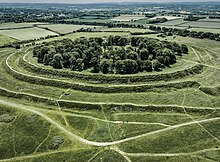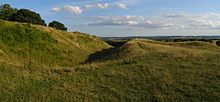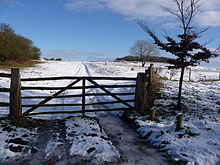Badbury Rings
 Badbury Rings from the north | |
| Location | Shapwick, Dorset grid referenceST964030 |
|---|---|
| Coordinates | 50°49′35″N2°03′05″W/ 50.8263°N 2.0515°W |
| Type | Hillfort |
| History | |
| Periods | Iron Age |
| Site notes | |
| Ownership | National Trust |
| Public access | Yes |
Badbury Ringsis anIron Agehill fortandScheduled Monumentin eastDorset,England. It was in the territory of theDurotriges.In the Roman era a temple was located immediately west of the fort, and there was a Romano-British town known asVindocladiaa short distance to the south-west.
Iron Age
[edit]Badbury Rings sits 327 feet (100 m) above sea level. There are two main phases of construction; the first covered 7.3 hectares (18 acres) and was defended by multiple ditches, while the second was more than twice the size, covering 16.6 ha (41 acres) and defended by a single ditch and rampart.[1]Bronze Ageroundbarrowsin the vicinity demonstrate an earlier use of the area.

Until 1983 Badbury Rings was privately owned as part of theKingston Lacyestate, and the owners discouraged investigation of the site.[2]The site now belongs to theNational Trust.[2]A survey of the hillfort by theRCHMEwas begun in 1993.[1]The summit area was cleared of undergrowth by the National Trust in 1997 and the conifer plantation was thinned out.[1]This allowed the RCHME to complete the survey in 1998, which recorded 28 potential hut sites within the ramparts,[3]although some depressions are probably caused by uprooted trees.[1]The first excavations, led by Martin Papworth, took place in 2004, when threeevaluation trencheswere dug.[3]Almost all of the pottery found was dated to the LateIron Age.[4]The current evidence does not suggest that the hillfort was a principal settlement in the Early Iron Age.[4]It seems likely that the hillfort became depopulated towards the end of the Late Iron Age, perhaps as theVindocladiasettlement near Shapwick developed.[5]

Badbury Rings is the fifth in a series of Iron Age earthworks,[6]starting fromHambledon Hill,and also includingHod Hill,SpetisburyRings,Buzbury Rings,Badbury Rings andDudsbury Camp.The Iron Age port atHengistbury Headforms a final Iron Age monument in this small chain of sites.
Roman roads
[edit]
During theRoman era,fiveRoman roadsformed a complex junction on the north side of Badbury Rings.
TheRoman Conquest of Britainbegan in AD 43. It is likely that theLegio II Augustacampaigned in Dorset under the command of the future emperorVespasian.About4 km (2+1⁄2mi) southeast of Badbury Rings, at Lake Farm,Ashington,nearWimborne,afortwas established.[7]A military road from the Lake Farm fort was created which passed by the northeast side of Badbury Rings.[8]Beyond Badbury Rings the road headed in a northwest direction (visible today as a thin strip of woodland) heading for the Roman fort atHod Hill.[8]At an early stage, this road formed a junction withAckling Dyke,a Roman road which headed northeast toOld Sarum(Sorviodunum).[9]Another road ran across country in a north by northwest direction towardsBath(Aquae Sulis),[10]and another ran south to a small port inPoole Harbour(Moriconium,modernHamworthy). The final road (still used as a modern trackway on the west side of Badbury Rings) ran in a southwest direction through the settlement ofVindocladiaheading towardsDorchester(Durnovaria). This final road was not built until the later Roman period.[11]
Romano-Celtic temple
[edit]Immediately west of Badbury Rings is the site of aRomano-Celtictemple. It is located within a polygonal boundary bank visible on aerial photographs. It was excavated as early as 1900, and again in 1952.[12]These excavations revealed stone roofing slabs, painted wall-plaster, and over 185 Roman coins, as well as 21Durotrigiansilver and bronze coins.[12]Pottery, glass beads, bronze pins, a bracelet and a brooch were also recovered.[12]Further excavations were conducted in 2000 which showed that the temple was in use from the 1st to 5th centuries.[13]
Vindocladia
[edit]
A short distance (1.5 km, 1 mi) to the southwest of Badbury Rings, between the hillfort and the modern village ofShapwick,lay a small Romano-British town (ST946022), believed to be that listed in theAntonine ItineraryasVindocladia(fromBrittonic*windos"white" +*klādiyos"ditch, earthwork" ). In the later Roman period, a small fort was also established on the east side of the town. The fort was only discovered in 1975,[14]and the existence of the town only came to light in the 1990s.
It has long been known that there was Roman activity in the area. A Roman pit and occupation debris were discovered in 1954 in the village of Shapwick, which includedSamian warepottery, a bronze coin ofClaudius,and a rim fragment of amortarium.[15]In 1990 anarchaeological field surveyrevealed three areas of building debris including roof andfluetiles,tesserae,and 2nd–4th century pottery.[16]Excavations, led by Martin Papworth, took place in 1991, 1995, and 2004. The 1991 excavations uncovered robber trenches, tesserae, pottery, painted wall plaster and evidence for ironworking.[16]The 1995 excavations demonstrated that the Roman occupation overlay numerous pits and ditches dating from the middle to late Iron Age,[17]and uncovered smithing hearths dating from the second century.[18]They further demonstrated that the Roman road through the settlement and the associated fort were not built until the later Roman period.[19]Excavation of the settlement's boundary ditch in 2004 uncovered early first-century pottery, including a Samian-ware platter, as well as a first-century brooch.[11]
The evidence suggests that the settlement began as a pre-Roman village or town of the late Iron-Age which continued in use in the Roman period.[11]Coins and pottery recovered from the site show that it was occupied until at least the 5th century.[11]Ageophysical surveyof the entire settlement has shown that the site covers 25 hectares. It appears to have been one of the biggest Roman towns in Dorset, second only to Dorchester (Durnovaria).[11]It is likely that the town was theVindocladialisted in theAntonine Itineraryas the only named place between Old Sarum (Sorviodunum) and Dorchester.[11]
The Roman fort is a rectangular enclosure with straight sides and rounded corners, surrounded by triple ditches.[14]It measures around 200 m × 160 m (220 yd × 170 yd) and encloses about 2.5 ha (6 acres).[14]It is located on the east side of the town. Pottery picked up on the ground in 1975 suggested a mid 1st-century date for the fort.[14]However, the subsequent excavations have revealed that the fort was not built until the later Roman period, and that the fort went out of use at the end of the Roman era.[11]The fort contained a large building complex, and may have been the site of an imperial inn, ormansio.[11]
Saxon era
[edit]Finds of late Roman material within the hillfort indicate that Badbury Rings was reoccupied, perhaps as security declined in thepost-Roman period.[20]The ancient frontier ofBokerley Dyketo the northeast was revived and may have played a role in keeping the invading Saxons out of Dorset during the 5th and 6th centuries.[20]
The identification of Badbury Rings withBattle of Mount Badon(first mentioned byGildas) was reported in the 19th century byJohn Hutchins[21]as originating with a supposition by the 'eminent DrEdwin Guest' in the Salisbury Volume of theArchaeological Institute.Local historian Roy Carr has suggested that the Saxons were held off from crossing Bokerley Dyke, by the threat of an army in the west, perhaps stationed at Badbury Rings.[22]Badbury Rings is one of three sites regularly advanced as the location of this battle, with the city ofBathalso recognised as a contender.
Edward the Elderbrought an army to Badbury, soon after his succession to the throne in 899, to face down a challenge to his claim for the crown by his cousinÆthelwold,based at nearbyWimborne Minster.[23]
Antiquarian accounts
[edit]TheTudorantiquarianJohn Lelandvisited Badbury Rings during hisItineraryof England conducted between 1538 and 1543. After speaking about the nearby town of Wimborne Minster he wrote:[24]
The Saxon Kinges had hard by the Toune a Castelle now caullid Badbyri, but clerely down. The Diches, Hilles, and Site ther of be yet evidently seene. nowConyesborough in it.
The site today
[edit]The site, on the dip slope ofCranborne Chase,is now part of theKingston Lacyestate owned by theNational Trustsince 1982, with free access. The hillfort has been a scheduled ancient monument since 1924.[25]On a clear day, the Isle of Wight is visible from the top.
Citations
[edit]- ^abcdHistoric England."BADBURY RINGS (209560)".Research records (formerly PastScape).Retrieved27 December2012.
- ^abPapworth 2011,p. 41
- ^abPapworth 2011,p. 155
- ^abPapworth 2011,p. 156
- ^Papworth 2011,p. 168
- ^‘Hill Forts of the Stour Valley’ by David E. C. Jardine, 1985, Bournemouth Local Studies Publications
- ^Field 1992,pp. 32–44
- ^abField 1992,pp. 50–57
- ^Putnam 2000,p. 43
- ^Putnam 2000,p. 44
- ^abcdefghPapworth 2011,p. 163
- ^abcHistoric England."Monument No. 209544".Research records (formerly PastScape).Retrieved22 April2013.
- ^Papworth 2011,p. 159
- ^abcdHistoric England."SHAPWICK 85 (209645)".Research records (formerly PastScape).Retrieved22 April2013.
- ^Historic England."Monument No. 209644".Research records (formerly PastScape).Retrieved22 April2013.
- ^abHistoric England."SHAPWICK 81 (1066560)".Research records (formerly PastScape).Retrieved22 April2013.
- ^Papworth 2011,p. 160
- ^Papworth 2011,p. 161
- ^Papworth 2011,p. 162
- ^abPapworth 2011,p. 178
- ^The History and Antiquities of the County of DorsetVolume III 1861–1874
- ^Carr 2001,pp. 5–7
- ^Miller, Sean (2004)."Edward (called Edward the Elder) (870s?–924), King of the Anglo-Saxons".Oxford Dictionary of National Biography.Oxford University Press.doi:10.1093/ref:odnb/8514.Retrieved5 January2016.(subscription orUK public library membershiprequired)
- ^Hearne 1768,p. 86
- ^Historic England(2021)."Badbury Rings (Grade Scheduled Monument) (1002679)".National Heritage List for England.Retrieved27 December2021.
References
[edit]- Carr, R. (2001), "Badbury or Badon",Dorset life,267:5–7
- Field, Norman H. (1992),Dorset and the Second Legion: New Light on a Roman Campaign,Dorset Books,ISBN1871164117
- Hearne, Thomas (1768),The Itinerary of John Leland the Antiquary: Publish'd from the Original MS. in the Bodleian Library by Thomas Hearne M.A.,Oxford
- Papworth, Martin (2011),The Search for the Durotriges: Dorset and the West Country in the Late Iron Age,The History Press,ISBN0752457373
- Putnam, Bill (2000),Discover Dorset: The Romans,The Dovecote Press,ISBN1874336741
Further reading
[edit]- Martin Papworth, (2011),The Search for the Durotriges: Dorset and the West Country in the Late Iron Age.The History Press.ISBN0752457373

